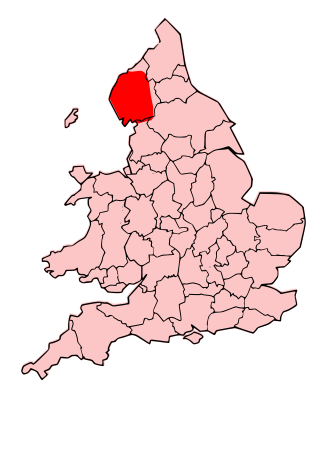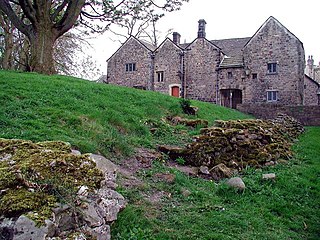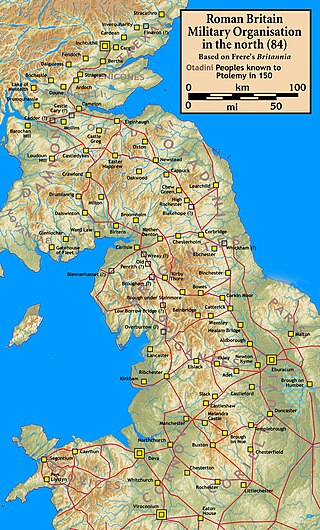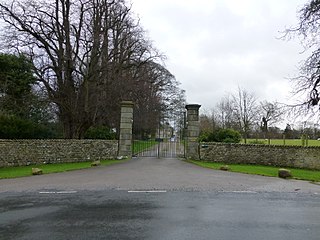Related Research Articles
In Romano-British religion, Cocidius was a deity worshipped in northern Britain. The Romans equated him with Mars, god of war and hunting, and also with Silvanus, god of forests, groves and wild fields. Like Belatucadros, he was probably worshipped by lower-ranked Roman soldiers as well as by the Britons for whom he was probably a tribal god - a genius loci.

The Carvetii were a Brittonic Celtic tribe living in what is now Cumbria, in North-West England during the Iron Age, and were subsequently identified as a civitas (canton) of Roman Britain.

Ilkley Roman Fort is a Roman fort on the south bank of the River Wharfe, at the centre of the modern town of Ilkley, a Victorian spa town in West Yorkshire, England.

Wetwang is a Yorkshire Wolds village and civil parish in the East Riding of Yorkshire, England, 6 miles west of Driffield on the A166 road.

Adel is a suburb of Leeds, West Yorkshire, England. To its immediate south is Weetwood, to the west are Cookridge and Holt Park, to the east are Alwoodley and Moortown, and to the north are Bramhope, Arthington and Eccup.

The Venicones were a people of ancient Britain, known only from a single mention of them by the geographer Ptolemy c. 150 AD. He recorded that their town was 'Orrea'. This has been identified as the Roman fort of Horrea Classis, located by Rivet and Smith as Monifieth, six miles east of Dundee. Therefore, they are presumed to have lived between the Tay and the Mounth, south of Aberdeen. Andrew Breeze has suggested that the tribal name probably means "hunting hounds". A slightly differing etymology, "kindred hounds", identifies the name with Maen Gwyngwn, a region mentioned in the Gododdin.

Gariannonum, or Gariannum, was a Roman Saxon Shore fort in Norfolk, England. The Notitia Dignitatum, a Roman Army "order of battle" from about AD 400, lists nine forts of the Saxon Shore in south and east England, among which one was called Gariannonor. It has been much discussed over the years in terms of spelling, purpose, and location. The fort is listed as being commanded by the Praepositus equitum stablesianorum, implying its garrison was a cavalry of a form originated in the late 3rd century, the Equites Stablesiani. Both proposed sites show archaeological evidence for military occupation beginning at around the time this type of unit began use.
The Cornovii is a hypothetical name for a tribe presumed to have been part of the Dumnonii, a Celtic tribe inhabiting the south-west peninsula of Great Britain, during some part of the Iron Age, Roman and post-Roman periods. The Cornovii are supposed to have lived at the western end of the peninsula, in the area now known as Cornwall, and if the tribal name were correct it would be the ultimate source of the name of that present-day county.

The Cornovii is the name by which two, or three, tribes were known in Roman Britain. One tribe was in the area centred on present-day Shropshire, one was in Caithness in northernmost Scotland, and there was probably one in Cornwall. The name has appeared in ancient sources in various forms, such as Cornavii, Cornabii, and Curnavii.

The Caersws Roman Forts are two Roman military camps at Caersws, Powys in Mid Wales. They were garrisoned during the occupation of Great Britain between the 1st and 5th centuries when this part of Wales was part of the Roman province of Britannia Superior. A surviving section of Roman road lies to the west of the encampments.

Londesborough is a village and civil parish in the East Riding of Yorkshire, England. It is situated approximately 2.5 miles (4 km) north of the market town of Market Weighton. The civil parish is formed by the village of Londesborough and the hamlet of Middlethorpe. According to the 2011 UK census, Londesborough parish had a population of 182, a reduction of one on the 2001 UK census figure.

Aballava or Aballaba was a Roman fort on Hadrian's Wall, between Petriana (Stanwix) to the east and Coggabata (Drumburgh) to the west. It is about one and a half miles south of the Solway Firth, and its purpose was to guard the south end of two important Solway fords, the Peat Wath and the Sandwath, which were also to become favourite routes for medieval border raiders.

Blatobulgium was a Roman fort, located at the modern-day site known as Birrens, in Dumfriesshire, Scotland.
Noviomagus, also known as Noviomagus Cantiacorum to distinguish it from other places with that name, was a Roman settlement in southeastern Britain. It is named on Iter II of the Antonine Itinerary, ten Roman miles from Londinium and nineteen to Vagniacis, thence nine miles to Durobrivae. Its location has been given as modern Crayford, but is now suggested to be near West Wickham following excavation of the Roman site there; the distances also fit West Wickham better than Crayford.
The gens Mussidia was a minor plebeian family at ancient Rome. Few of the Mussidii attained the higher offices of the Roman state, although Titus Mussidius Pollianus obtained the consulship in the time of Caligula. Other members of this gens are known from inscriptions.

Lancaster Roman Fort, also known as Wery Wall, Galacum or Calunium, is the modern name given to ruined former Roman fort atop Castle Hill in Lancaster in North West England. The first castra was founded c. 80 AD within the Roman province of Britannia.

Over Burrow Roman Fort is the modern name given to a former Roman fort at Over Burrow, Lancashire in North West England. Today it is the site of the 18th-century country house Burrow Hall. The first castra is thought to have been founded in the first century AD within the Roman province of Britannia.
Adelfius was a Romano-British bishop, possibly from Londinium (London), Lindum (Lincoln), Camulodunum (Colchester) or Legionensium (Caerleon), who was part of the British delegation who attended the church council held at Arles, in Gaul, in AD 314.
The Ecdinii or Ecdini were a Gallic tribe dwelling in the valley of the Tinée (Alpes-Maritimes) during the Iron Age.
References
 This article incorporates text from a publication now in the public domain : Smith, William, ed. (1854–1857). "Delgovitia". Dictionary of Greek and Roman Geography . London: John Murray.
This article incorporates text from a publication now in the public domain : Smith, William, ed. (1854–1857). "Delgovitia". Dictionary of Greek and Roman Geography . London: John Murray.
- ↑ Pitts Capper, Benjamin (1825). A Topographical Dictionary of the United Kingdom. London. p. 669.
- ↑ Rivet, A. L. F.; Smith, Colin (1979). The Place-Names of Roman Britain. London. pp. 331–332.
{{cite book}}: CS1 maint: location missing publisher (link) - ↑ "Delgovicia/Delgovicivm?". Roman Britain.
- ↑ Wilson, Pete (2017). "Derventio, Delgovicia and Praetorio: Some Roman-Period Place-Names of Eastern Yorkshire Revisited". Britannia. 48: 305–8. doi:10.1017/S0068113X17000058.